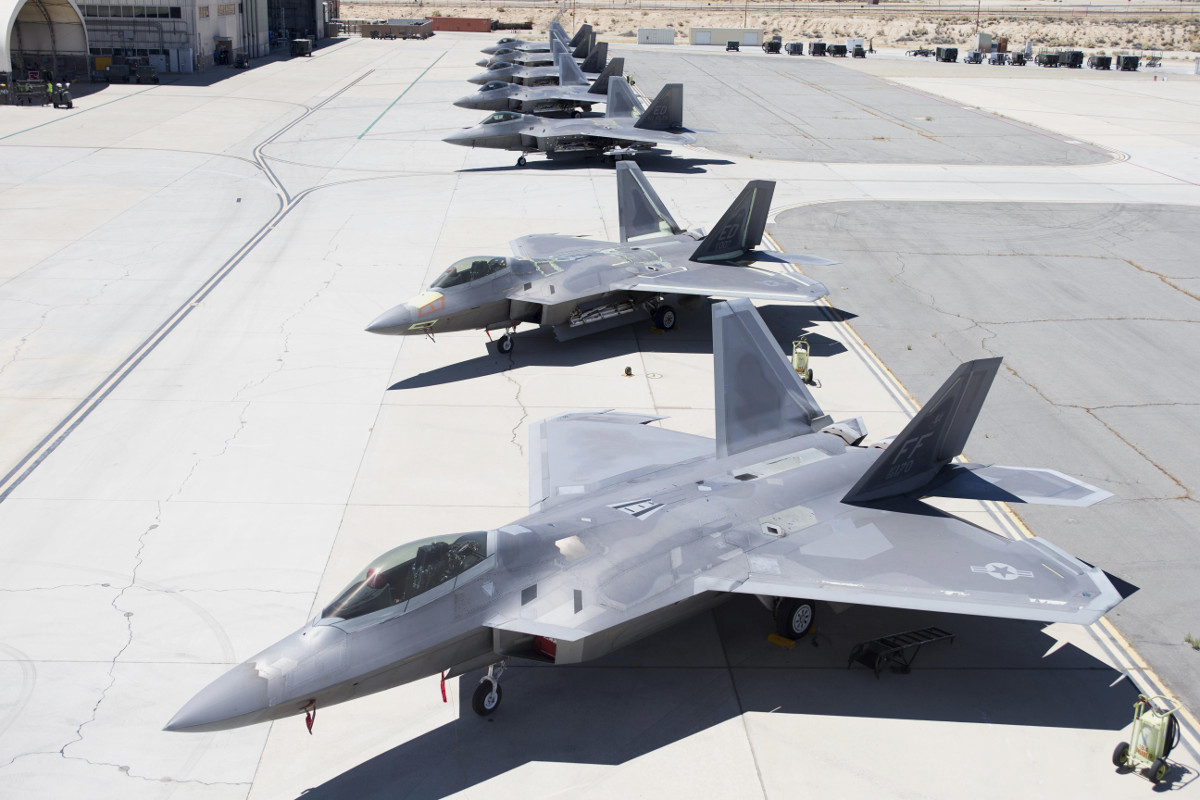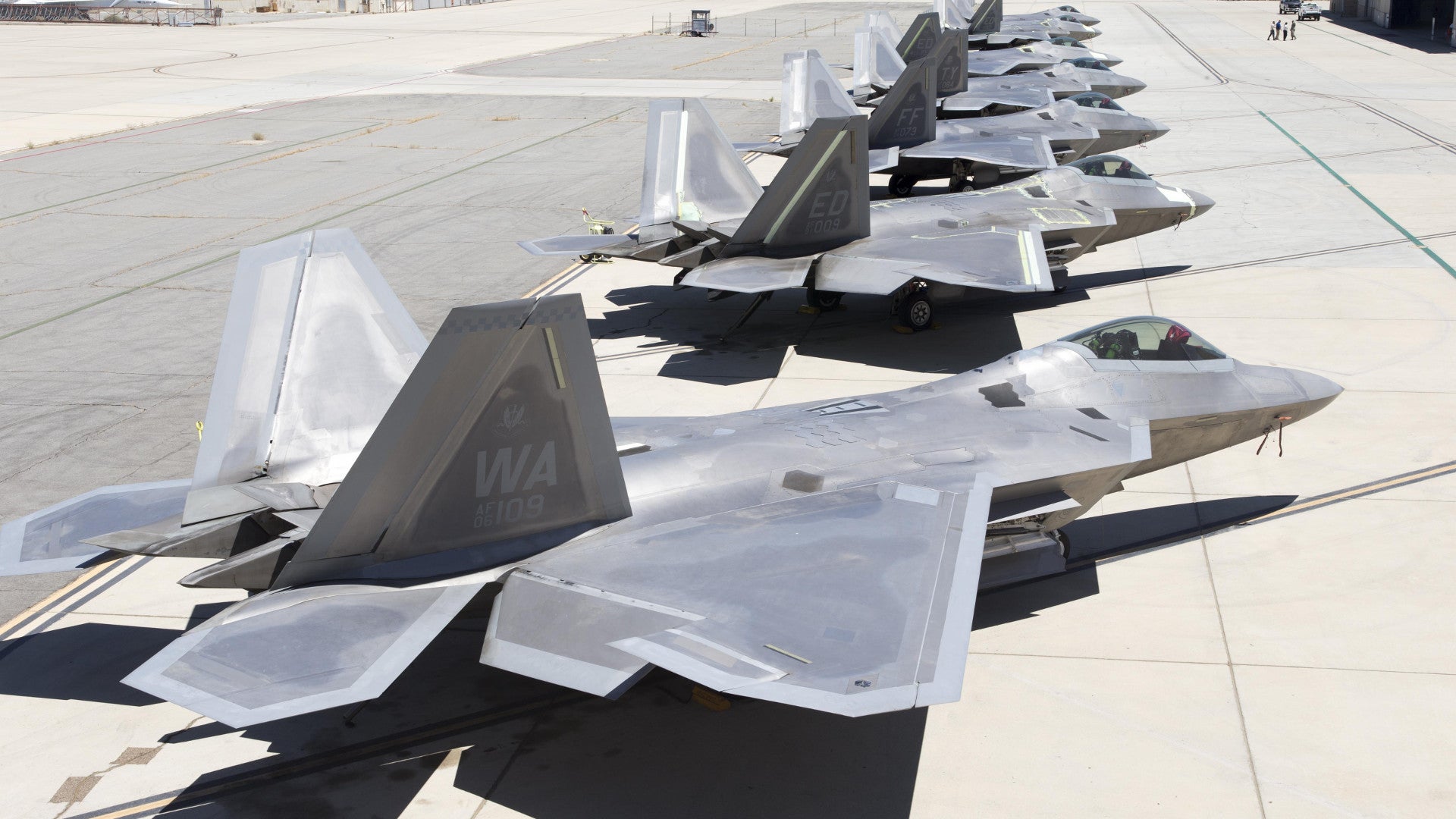The U.S. Air Force may have shot down recent plans to restart production of the F-22 Raptor, but it will soon add one more of the stealth fighters to its active fleet. The service has pulled one the jets out of mothballs in order to expand its operational test force as work continues to expand the capabilities of the combat-coded jets.
The Air Force confirmed to FlightGlobal that it was in the process of rehabilitating an Raptor, with the serial number 91-4006, at Edwards Air Force Base in California. Edwards is home to the 411th Flight Test Squadron, which oversees the F-22 Combined Test Force (CTF).
The Raptor, which is a Block 10 aircraft, had been in flyable storage. An Air Force spokesperson told FlightGlobal that it would take $25 million bring the plane’s avionics up to Block 20 standards, as well as update its electrical and hydraulics systems and flight controls.
In its budget request for the 2018 fiscal year, which it released in May 2017, the Air Force noted the plan to bring the older Raptor back into service. The service also requested $54.6 million for the F-22 CTF, a nearly $6 million increase over money it received for the test force in the previous fiscal cycle.

Expanding the CTF is extremely important for the future of the F-22s, especially with no plans to restart the production line and build new Raptors with more modern systems. Of the 187 jets that remain in service, only 125 of them are combat ready at any one time, with the bulk of the rest going through the upgrade or maintenance pipelines or sitting in flyable storage.
It goes without saying that the decision to buy so few of the jets has long been controversial and repeatedly prompted calls to put the F-22 back into production. The Air Force has already conceded that it was shortsighted to end the production of the stealth fighters early. The service has also been compelled to acknowledge, at least tacitly, that it was optimistic to think that the F-35 Joint Strike Fighter would be able to supplant the Raptor force and take over for most existing fourth generation fighter aircraft in the near future.

In June 2017, despite earlier suggesting it might be an possibility, the Air Force seemed to finally put an end to the discussion after delivering a report on the subject to Congress that explained it would cost approximately $50 billion to build another 194 Raptors. The War Zone’s own Tyler Rogoway had this to say about the service’s verdict:
In many ways this actually beats some cost estimates as far as restarting the production line. And at roughly $200 million per jet, the USAF could buy two F-35s for a single new F-22. But comparing the two is troublesome, as with both jets are in inventory and you don’t need anywhere near the numbers of Raptors as you do F-35s. Additionally, buying more F-22s could (and should) mean less F-35s would be required depending on how you look at the USAF’s overall force structure. Not just that, but involving other countries in the restart, notably Japan and possibly Australia, these costs to the USAF alone can come down.
The big question as we highlighted before is what is a “new” F-22? Does it have an avionics system based on the F-35? Is it tailless and stretched to increase its stealthiness, range and weapons payload? Or is it a F-22 as we have today with basic upgrades to its computers and materials where necessary to accommodate modern production lines and techniques? The former is likely what the numbers above depict.
But the F-22 remains the undisputed air supremacy fighter the world over, it has proven itself invaluable in Syria, and even the USAF has admitted the F-35 is no match for the jet’s extreme capabilities for certain key missions sets. But with a new bomber in the works, the need to upgrade or totally replace rapidly aging legacy fighters, as well as a whole other avalanche of priorities that are battling it out over the Pentagon’s unpredictably sized piggybank, realizing a Raptor production reprise remains just as doubtful as ever. Even the F-22 force the USAF already has is lacking key capabilities due to poor priorities and funding shortfalls.
That last point is particularly important with regards to the CTF. Less well publicized is that the decision to buy less than 200 jets, combined with other budget cuts, had a significant impact on the testing of new, essential upgrades to the aircraft’s mission equipment to keep the Raptors just capable in the face of ever advancing potential threats.
In the early 2000s, the CTF had seven F-22s of its own for test purposes. By September 2016, this number had dropped to just four aircraft. On at least one occasion, the Air Force pull combat coded jets and their pilots off their primary duty to bolster the experimental fleet.

A fifth full-time test jet will be a boon to ongoing upgrade work, most notably the Increment 3.2B software. The Air Force says this update will “biggest capability upgrade since reaching Initial Operating Capability in December 2005.”
In addition to the 3.2B software, the Air Force’s budget request says the CTF will support improvements to the F-22’s sensor suite, a set of National Security Agency-mandated updates to encryption capabilities of the aircraft’s communications gear and data links known as Update 6, and work on the Flutter Excitation System (FES) and Common Range Integrated Instrumentation System (CRIIS), according to the official budget documents.

On top of that there will be flight tests of unspecified “advanced technology developments” that could include new, classified capabilities for the aircraft. This could include offensive or defensive directed energy weapons, which the Air Force says it is interested in integrating into its fifth generation fighter fleet and whatever comes next.
It’s possible that expanding the test force might provide extra capacity in the near future for work on other important updates, such as improvements on the aircraft’s data sharing capabilities. The continued lack of a helmet-mounted display for Raptor pilots also limits the aircraft from realizing its full potential. The War Zone’s Tyler Rogoway has written in depth on this glaring omission.
Whatever the F-22 CTF does find itself doing in the coming year, it will have a fifth aircraft to help, and that can only be good for the fleet as a whole.
Contact the author: joe@thedrive.com
